When we bought Winterlude, our 1985 Passport 37, there was a perfectly functional manual windlass on the bow. During our first commuter cruise in 2001 — from Annapolis MD to New Bern NC, the manual windlass developed a crack in the cast iron and we couldn’t use it. We tried to get it welded in New Bern, and although promises were made that it would be good as new when we returned the following month, we were without our windlass on the sail from New Bern to Canaveral Florida. Grumble. But we were able to get it successfully welded in Canaveral.
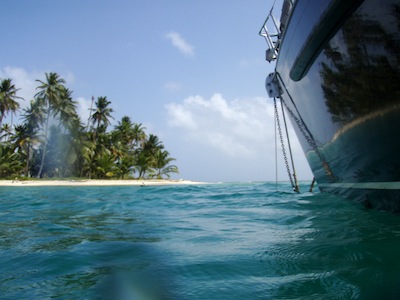
Fast forward 4 years, now we’re ready to leave to go cruising the Northwest Caribbean … Mexico’s Yucatan Coast, Belize and the Rio Dulce, Guatemala. As we’re spending more time talking to “real” cruisers, we keep hearing stories about how important an electric windlass is and how it can save your boat.
What? Our manual windlass works fine. Of course, ever since we added 150 feet of 5/16 high test chain, it’s been a bit more of a struggle to get the chain and 44 lb Spade anchor up than it was when we bought the boat with 30 feet of chain (maybe) connected to nylon rode and a 45 lb CQR.

As we get older, it’s harder and harder to think about re-anchoring over and over to get the anchor to set well in the thin sand over rock in Belize or for that matter, Isla Mujeres. Trying to find that special patch of deep enough sand to bury the anchor can be frustrating. But the consequences of NOT redoing the anchor to set well can be catastrophic. The only times we have ever dragged anchor was because we had reset the anchor numerous times and finally just got frustrated and said “good enough” – when we really hadn’t backed down hard. Luckily both times we were able to reset – once in the dark of night with sideways torrential rain – without kissing coral.
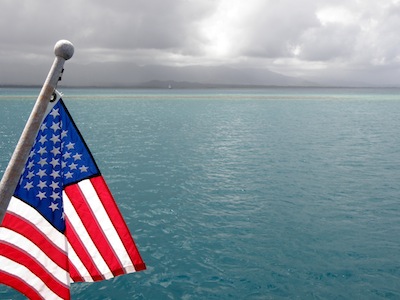
After hearing yet another story about cruisers not re-anchoring because they were physically exhausted from bringing the anchor up with the manual windlass, we decided one month before we were scheduled to leave to go cruising that we should invest in an electric windlass. Our choice was a Lighthouse 1501. And we have never regretted the decision.
The skeptics said … don’t buy an electric windlass, electric stuff never functions when you really need it. And although there’s plenty of truth in that statement, preventative maintenance along with a dedicated windlass battery (we couldn’t easily run big enough wire through the boat to power the new windlass, it was going to be less expensive in the long run to add the dedicated battery — of course, that added weight in the bow, which wasn’t our favorite. And the windlass operates manually as well with a winch handle, so in a real emergency, we could get the anchor up without help of electricity … well, maybe…..
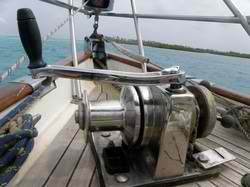
So if you’re debating whether or not to spend the money on an electric windlass, imagine yourself in a pristine tropical anchorage with swimming pool clear water. You’ve just eyeballed your way through the reef to the anchorage, and there’s reef behind you. You drop the anchor in what looks like a sand patch, but it doesn’t hold because there’s not enough sand. So you pick it up and try again in a slightly different spot. It’s hot, the sun is high. You back it down and it just drags through the sand. Ugghhh… finally after multiple tries in slightly different spots, you get it to hold and now you put on your snorkel & fins to go check it up close and personal … oh no, it’s on it’s side with only part of the fluke buried… back to the anchoring dance dilemma. Now imagine the same scenerio in the middle of the night when a wind switch puts you on a lee shore… It’s not usually so demanding, but with the electric windlass, we’re not as reluctant to pick it up and try again. Especially when we realize the consequences of NOT making sure it’s buried properly. 🙂

Do you have an electric or manual windlass? Leave a comment or more information and share! Thanks! Jan
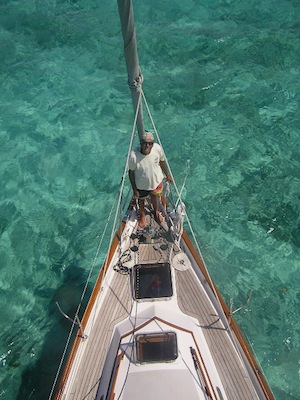

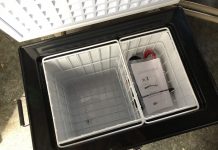








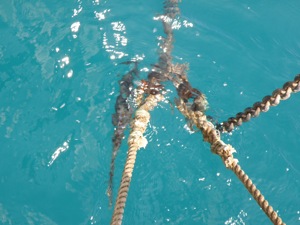
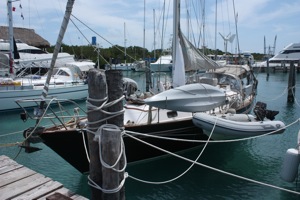
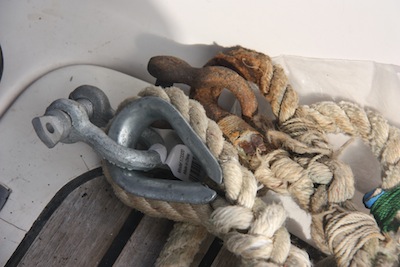
Thanks for the great input,
currently debating same. We have manual but want to go automatic. Our dilemma is electric vs hydraulic. We have a electric/hydraulic powerpack which powers in-mast mainsail/lifting keel and main winches so could use it to power anchor windlass but running the hydraulic tubes forward will not be easy but it would avoid electrics up front. Any views on pro’s/con’s of electric vs hydraulic very welcome. Thanks!
Hi! We don’t have any personal experience with hydraulic and as far as I know none of our cruiser friends use hydraulic either. The research I did shows that it is a viable solution but the main problem is cost. Apparently it’s more expensive than electric, although since you already have the powerpack, it may be cost effective as well.
The other concern I’d have would be maintenance/repair. Depending on where you’re planning to cruise, it might be more difficult to get something fixed, especially in remote cruising areas. Other areas of the world are familiar with electric motors and you can get one rewound just about anywhere. I’m not sure what the comparable repair in hydraulic might be, but it might be less familiar to someone say in the Rio Dulce of Guatemala. Or even the Bahamas.
Let us know what you decided and how it’s working! Cheers! Jan
We’re just getting ready to prep our sailboat for cruising, but an electric windlass is definitely on our list! We want to save our backs!
We’ve been using our Simpson Lawrence manual windlass to manage our 300′ of 5/16ths high tensile chain for the last 15 years. I do think it would be easier if ours was electric, but we are careful to choose our spot and set things right the first time. But, as I get older, I worry about being able to retrieve the anchor and chain, especially from a deep anchorage, where we’ve had a lot of chain out. On the other hand, it always works, and short of a greasing now and then, needs no maintenance at all.
You’re right — one of the top advantages of the manual windlass is you never step on the up button and hear silence. Grrr…. the windlass takes a fair bit of preventative maintenance to keep the connections corrosion free. But as long as we invest the time keeping the corrosion away, it’s been a reliable piece of gear. Thanks Mike!
We have an old Sea Tiger manual windlass and I was also debating this issue. I’ve certainly had my share of re-anchoring (my record is 5 times, but it turned out I wasn’t being patient enough to allow my 45lb. CQR to settle properly before beginning my back-down procedure). Anyways last summer I had an interesting chat with Terry Plain on sv Cristata. He has the same windlass and shared this idea: he got a new winch handle made of SS but an extra foot longer for better leverage. Brilliant.
So, for $30 I’m going to try that out first and see if I can keep the Sea Tiger for a few more years.
I too have poured over this idea, and I settled with a manual windlass because I too don’t want the weight up front, nor the extra stuff/cost/maintenance/R&R/etc, but I found that I killed the (supposedly) dedicated battery on a booze cruise we rented, and it was a 3 or 4 year old well respected boat builder. I know it could have been a bad battery, but this boat was used all the time, checked out and very well maintained, it was privately owned and the owner did lots of things extra, so it wasn’t the usual barefoot charter, and I set off all kinds of alarms pulling up the 100+ feet of chain and anchor at the Baths, in the BVIs. When I started talking to my other sailing friends when I got home, they said, yea, you get a couple of tries when trying to set an anchor, but after about three, you have to wait for the batteries to recharge. Hmm, I’ve been a sailor for many years, worked on just about every mechanical under the sun over the last 40+ years (I’m 51 and started tearing stuff apart at the age of 6, started being able to put things back together at the age of 10 or 11), so I believe that my experience could be a one-off and no one else has had that experience, but I also try to learn from others, try to not make the same mistakes, and I firmly believe the people who told me that even with an electric, that I might have to do it manually. I fully understand the wearing out as you get older, but I may just get a longer handle for the one I have, and get some exercise out of it, lord knows I need more of that. Thanks for the pic and info!
s/v Renasci
I’ve never used a manual windlass before but I can image with a heavy anchor and bunch of chain let, you would hope for a good set the first time. I’ve had great luck with my Maxwell vertical windlass, but I sealed it up real good when I installed it 8 years ago. I always wondered if the electronics of a horizontal unit take more of a weather beating and involve additional maintenance. About all I’ve done is spray the connections every few years with terminal protectant.
We will be taking our hydraulic windlass off our 1923 boat (they didn’t have hydraulics in the roaring 20ies anyway) and install a manual Simpson-Lawrence SZL500 – a big black beast, but working nicely under all conditions and easy to service. If manual winching seems too hard for you just get a longer handle and give it another try; you will be surprised at the improvement and how easy it is. I at least don’t have to waste any money on “fitness centres”, just raise the anchor manually and the hoist all our sails manually keeps me perfectly fit – and it’s fin
I have had my 31ft boat for five years and never been anywhere due to personal circumstances too lengthy (and boring) to explain. The time is close at hand when I may be in a position to set sail or sell. I have enjoyed some sailing over the years including being part of a crew crossing the Atlantic,what a fantastic experience.My boat has no windlass at all and have pondered manual or electric for far too many hours from the comfort of my armchair. I really have enjoyed the very informative personal stories on different sites and the many conclusions. Despite my age,81 ,I feel I could have managed a manual windlass quite comfortably until two years ago when I had an operation which rules out totally manual.My solution seems to be electric with manual option.Thank you to all who have made this and other subjects very interesting and entertaining.One question …..in some instances why are manual windlass nearly the same price as an electric one ?